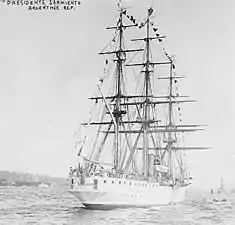34°36′32.23″S 58°21′56.31″W / 34.6089528°S 58.3656417°W
 Moored at Puerto Madero, Buenos Aires | |
| History | |
|---|---|
| Name | Presidente Sarmiento |
| Namesake | Domingo Faustino Sarmiento |
| Builder | Laird Brothers, Birkenhead, England |
| Launched | 31 August 1897 |
| In service | 1897 |
| Out of service | 1961 |
| Status | Museum ship in Buenos Aires, Argentina |
| General characteristics | |
| Type | Sail training ship |
| Displacement | 2,750 tonnes |
| Length | 81 m (266 ft) |
| Beam | 13.11 m (43.0 ft) |
| Draught | 5.64 m (18.5 ft) |
| Propulsion | Steam, 3-cylinder compound, 1,000 hp (750 kW), ship rig |
ARA Presidente Sarmiento is a museum ship in Argentina, originally built as a training ship for the Argentine Navy and named after Domingo Faustino Sarmiento, the seventh President of Argentina. It is considered to be the last intact cruising training ship from the 1890s.[1]
History
The ship was originally built for the Argentine Naval Academy. ARA Presidente Sarmiento made thirty seven annual training cruises including six circumnavigations of the globe. The ship was retired as a seagoing vessel in 1938, but continued to serve without sails on Argentine rivers around 1950 and as a stationary training ship until 1961.
It is now maintained in its original 1898 appearance as a museum ship in Puerto Madero near downtown Buenos Aires.
Propulsion and auxiliaries
Rigging
Engine
In addition to its sailing rig this ship includes a large triple expansion steam engine supplied by two coal-fired boilers exhausting through the rear stack. An additional auxiliary boiler exhausting through the forward stack provides steam for other than propulsion, including two engines driving electrical generators on the main deck (below the weather deck).
Fuel
A single coal bunker is positioned between the main and auxiliary boiler rooms
Steering

A three-wheel chain drive allows up to six helmsmen to control the rudder. Such a crew of operators was not always required due to the inclusion of an electric servo-drive for normal operation but was useful for the training of cadets.
Armament
Artillery
.jpg.webp)
Four Armstrong gun mounts are positioned amidships, two on each side, with additional smaller weapons. The museum information indicates those as 5-inch pieces, but Norman Friedman identifies those as 120-mm L45 Elswick Pattern Y. Documentation on the ship shows these having had some armor, but the present installations are bare.
Torpedoes
A single torpedo scuttle using gravity expulsion exited at the bow. The scuttle has been removed and the exit port welded shut, but in the current museum configuration a torpedo is suspended in a position on the main deck ready to enter the former scuttle entrance. Additional torpedo storage is provided below this main deck.
Historic images
.jpg.webp) 1873 image of the ship's namesake
1873 image of the ship's namesake 1909 image of the ship
1909 image of the ship Capitan A. Brana and staff, Hamburg, 1923
Capitan A. Brana and staff, Hamburg, 1923 Cadets honor guests, Bremerhaven, 1931
Cadets honor guests, Bremerhaven, 1931 Publication allusive to its fiftieth anniversary, 1947
Publication allusive to its fiftieth anniversary, 1947
Museum
It is moored in Puerto Madero close to the Bicentennial Plaza and is now the ARA Presidente Sarmiento Frigate Museum.[2]
See also
- ARA Uruguay, a smaller historic tall ship moored nearby in basin number three.
- Argentine peso moneda nacional; the ship was featured on the 5 peso coin from 1961 to 1968.[3]
References
Notes
- ↑ Brouwer, Norman J. (1999). The international register of historic ships. London: Chatham Pub. ISBN 0-930248-11-2.
- ↑ Google Satellite View, accessed March 11, 2023
- ↑ "1965 Argentina 5 Peso". Archived from the original on 7 July 2011. Retrieved 31 January 2011.
Bibliography
External links
- Google Maps location of the Presidente Sarmiento
- "Buque Museo Fragata Presidente Sarmiento". Armada Argentina. Archived from the original on 28 September 2013. Retrieved 26 December 2009.
- Google translation of above